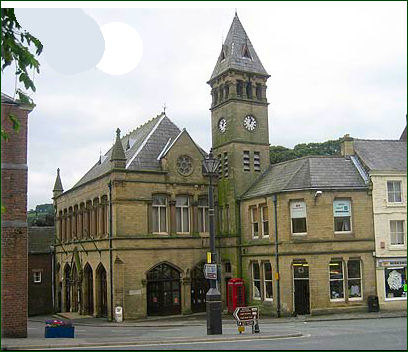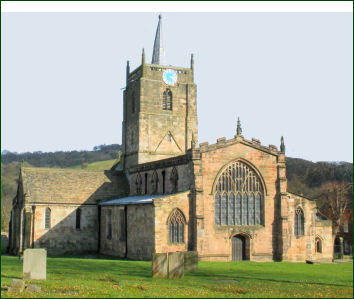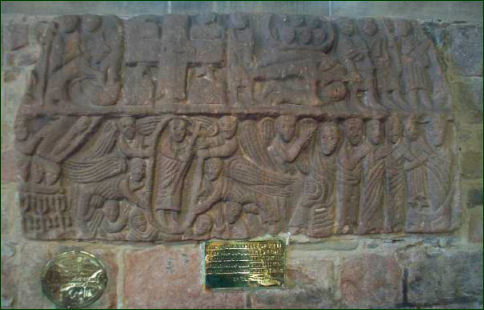Wirksworth
OS Grid ref:-
 The historic Derbyshire market town of Wirksworth, situated some four miles from Matlock, is a popular location from which to explore the Peak District and offers a range of accommodation for visitors.
The historic Derbyshire market town of Wirksworth, situated some four miles from Matlock, is a popular location from which to explore the Peak District and offers a range of accommodation for visitors.
Wirksworth is listed in the Domesday Book of 1086. The town was granted its market charter by Edward I in 1306.
Once the thriving southern centre of the Derbyshire lead industry, around Wirksworth's marketplace are many fine old buildings with picturesque alleys and craftsmen's yards. An area of narrow streets and alleys known as The Dale and Greenhill, houses many surviving old cottages and uses of lead merchants, notably a magnificent sixteenth century house known as Babington House, once the home of Anthony Babington, who was executed in 1585 for attempting to aid Mary Queen of Scots escape from prison.
The Wirksworth Heritage Centre stands just off Market Place in Crown Yard. The exhibition displays the history of Wirksworth from its prehistoric Dream Cave where the remains of a woolly rhino was discovered in the nineteenth century, through its Roman and lead mining histories, to the modern era.
One of the town’s unique attractions is the National Stone Centre, which offers activities such as gem-panning and fossil-casting. Likewise, the North End Mills allow visitors to see how hosiery has been made. Other nearby attractions include the Ecclesbourne Valley Railway and the Steeple Grange Light Railway.
 Perhaps the finest building in Wirksworth is St Mary's Church (pictured right), which was one of the first centres of Christian teaching in England and is believed to date to around 653 AD.
One of the rectors of Wirksworth was Anthony Draycot who served from 1535 until his imprisonment in 1560. Draycott was the judge at the heresy trial of Joan Waste.
Perhaps the finest building in Wirksworth is St Mary's Church (pictured right), which was one of the first centres of Christian teaching in England and is believed to date to around 653 AD.
One of the rectors of Wirksworth was Anthony Draycot who served from 1535 until his imprisonment in 1560. Draycott was the judge at the heresy trial of Joan Waste.
St Mary's is notable for its Anglo-Saxon carvings (pictured below) , and a large Anglo-Saxon coffin lid which was discovered in the churchyard in 1820. It is now mounted on the north wall of the nave. It appears to date from the second half of the seventh century. The church also contains an Anglo-Saxon carving of a lead miner, T'owd Man, the oldest representation of a miner any where in the world. It was moved here in 1863 from Bonsall church for safe-keeping and has never been returned. The parishioners of Bonsall have had a replica carved for their church.
 In the north aisle are the tombs of the Gell family. Sir Anthony Gell (d. 1583), has his statue on his tomb. Alongside is the simpler tomb of his father, Sir Ralph Gell.
The chancel contains the tomb of Anthony Lowe, a Gentleman of the Bedchamber who served Henry VII, Henry VIII, Edward VI and Mary I and died in 1555
In the north aisle are the tombs of the Gell family. Sir Anthony Gell (d. 1583), has his statue on his tomb. Alongside is the simpler tomb of his father, Sir Ralph Gell.
The chancel contains the tomb of Anthony Lowe, a Gentleman of the Bedchamber who served Henry VII, Henry VIII, Edward VI and Mary I and died in 1555
The town was for many years under the influence of the Gell family who were based at nearby Hopton Hall. Sir Anthony Gell founded the local school in 1546 and Sir John Gell was a Parliamentary comander in the Civil War. Both are buried in the church. Another historical link is with George Eliot, who based the character of Dinah Morris in her book 'Adam Bede' upon her aunt Elizabeth Evans, who lived in Wirksworth and was a Methodist preacher. Her house may still be seen.
The town holds a welldressing ceremony in Whit week, and every September the unusual ceremony of 'Clypping' occurs, in which the church is encircled by the congregation holding hands around it.
Nearby places of interest
Lea Gardens are situated near the town of Matlock. The garden nestles in a south west facing slope at an height of 700 feet above sea level on the northern edge of the Amber Valley, with scenic views of the Peak District hills beyond.
Lumsdale Valley, above the town of Matlock, is a thickly wooded gorge of outstanding natural beauty and a very interesting history, with stone ruins, waterwheels, ponds and waterfalls.
Chatsworth House known as "The Palace of the Peak" is the country seat of the Duke of Devonshire and is situated on the banks of the River Derwent, 3.5 miles to the northeast of Bakewell in the heart of the Peak District National Park.
Dovedale a dramatic limestone ravine, with its impressive rock outcrops and tranquil woodlands is arguably the prettiest and most famous of the dales in the Peak District National Park.
